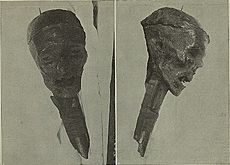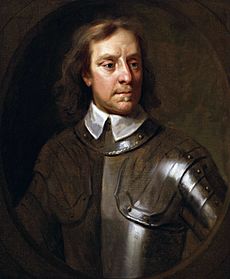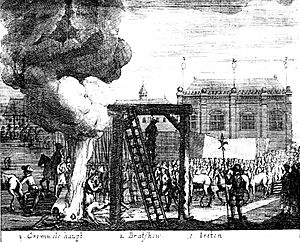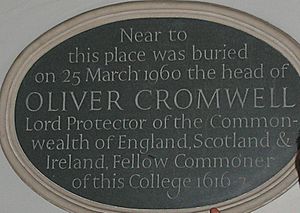Oliver Cromwell's head facts for kids
Quick facts for kids Oliver Cromwell's head |
|
|---|---|
| Present location | Sidney Sussex College |
Oliver Cromwell was a very important leader in England. He became the ruler, known as the Lord Protector, after the English Civil War. This war ended with King Charles I being removed from power and executed. Cromwell died naturally on September 3, 1658. He was given a huge public funeral, just like a king.
After Cromwell's death, his son Richard took over, but he was quickly overthrown. This led to the monarchy being brought back with King Charles II. In January 1661, the new government ordered that Cromwell's body, along with those of John Bradshaw and Henry Ireton, be dug up from Westminster Abbey. They were then taken to Tyburn for a posthumous execution (meaning an execution after death).
The three bodies were hanged for many hours before being cut down and beheaded. Their heads were then placed on 20-foot (6.1 m) poles. These poles were put on the roof of Westminster Hall, which was where King Charles I had been tried.
Cromwell's head stayed on Westminster Hall until at least 1684. It is believed that during a big storm in the late 1680s, the head was blown off its pole. A guard supposedly found it and took it home. After this, the head was owned by several private collectors and museums. Finally, on March 25, 1960, it was buried at Sidney Sussex College in Cambridge. This was the college Cromwell attended when he was younger.
Over time, what the head meant changed. At first, it was a scary warning from the king. But by the 1700s, it became a historical curiosity, something interesting to look at. Many people wondered if the head was real or a fake. Scientists later studied the head very carefully. They concluded that it was almost certainly Oliver Cromwell's head.
Contents
Oliver Cromwell's Early Life and Death
Oliver Cromwell was born on April 25, 1599. He led the Parliamentarian army during the English Civil War. After his army won, England became a republic called the Commonwealth of England. The monarchy and the House of Lords were abolished after King Charles I was executed in January 1649.
Cromwell became Lord Protector in December 1653. His rule was quite similar to how kings ruled before him. He had a lot of power and lived in royal palaces. In 1657, he was offered the title of King, but he turned it down after much thought. In 1658, Cromwell became ill and faced family sadness. He died on September 3, 1658.

Cromwell's death and funeral were treated with great respect, just like those of English monarchs. On September 20, his body was moved to Somerset House for a public viewing. This opened to the public on October 18. His body had been preserved and placed in a lead coffin, inside a decorated wooden one. A lifelike statue of him was placed next to it.
The statue was dressed in royal symbols, including a rich velvet suit and a royal robe. It also had a "Cap of Regality" (a royal hat) and an "Imperial Crown" on its cushion. The grand funeral procession happened on November 23, 1658. However, Cromwell's body had already been buried at Westminster Abbey two weeks earlier because it was decaying quickly. A special structure, called a catafalque, was built to hold his coffin. It was even grander than the one for King James I.
Cromwell's body stayed in Westminster Abbey until the monarchy was restored in 1660. King Charles II, son of the executed king, returned to power. The new government ordered the posthumous execution of Oliver Cromwell, John Bradshaw, and Henry Ireton. These men were considered traitors because of their role in the king's execution. The law said that a traitor's remains belonged to the King. Traitors' heads were often displayed in public places like bridges or the Tower of London.
Cromwell's body was hidden in a wall of the Henry VII Lady Chapel at Westminster Abbey. It was difficult to dig up. On January 28, 1661, Cromwell's and Ireton's bodies were taken to the Red Lion Inn in Holborn. John Bradshaw's body joined them the next day. Then, they were all taken to Tyburn for execution.
On the morning of January 30, 1661, which was the anniversary of King Charles I's execution, the bodies were dragged on a sledge through London's streets. They were then hanged in public until about four in the afternoon. After being taken down, Cromwell's head was cut off with eight blows. It was then put on a metal spike on a 20-foot (6.1 m) oak pole and raised above Westminster Hall.
Some stories say that Cromwell's daughter, Mary, rescued his body from the pit where it was supposed to be thrown. She supposedly buried it at her husband's home. A sealed stone vault there is said to hold his headless remains. However, the family has always refused to open it. Most historians believe Cromwell's body was simply thrown into the pit at Tyburn and stayed there.
The Head's Journey
From Westminster Hall to a Collector
Cromwell's head stayed on a spike above Westminster Hall until at least 1684. It was briefly removed in 1681 for roof repairs. We don't have clear records of where the head was from 1684 to 1710. However, a popular story says that during a big storm in the late 1680s, the pole holding the head broke. The head fell to the ground. A guard found it, hid it under his cloak, and took it home.
The loss of the head was a big deal in London. Many people searched for it because a large reward was offered for its return. But the guard was too scared to tell anyone he had it. The first clear record of the head after it disappeared from Westminster Hall was in 1710. It was owned by Claudius Du Puy, a Swiss-French collector of interesting objects. He displayed it in his private museum in London. Du Puy's museum was very famous and attracted many visitors. He once boasted he could sell the head for 60 guineas (a lot of money back then).
Changing Hands: Russell and Cox
When Du Puy died in 1738, the head's importance had changed. When it was on Westminster Hall, it was a scary warning. But by the 1700s, it was just an interesting item. The head was not well known again until the late 1700s. It was then owned by Samuel Russell, a failed actor who was said to be related to Cromwell. Russell tried to sell the head to Sidney Sussex College but failed.
Around 1780, a famous goldsmith named James Cox saw the head. He was sure it was Oliver Cromwell's head. Cox offered £100 for it, but Russell refused to sell, even though he was poor. Russell saw it as a sacred family item. Russell did not take good care of the head. He would pass it around at parties, which damaged its features. Cox found a different way to get the head. He lent Russell small amounts of money. When Russell couldn't pay back the loan, his only choice was to give up the head. In April 1787, Cox legally became the owner. Cox likely wanted the head as an investment to sell later.
In 1799, Cox sold the head to three brothers, the Hughes, for £230. The brothers wanted to start their own display in Bond Street. They bought the head along with other items related to Cromwell. They made thousands of posters for their exhibit. However, people doubted if the head was truly Cromwell's. The Hughes brothers asked Cox about the head's history, but he avoided their questions. This made them worry they had bought a fake.
The exhibition was not successful. The entrance fee was high (two shillings and sixpence, which was about £5 today). Also, rumors that the head was a fake spread widely.
The 19th and 20th Centuries
Even though the Hughes brothers' exhibition failed, a daughter of one of the Hughes continued to show the head. She offered it to Sir Joseph Banks, but he refused to see "the remains of the old Villanous Republican." William Bullock also thought about buying it. He wrote to Lord Liverpool, who said it would be wrong to show human remains in a public museum.
Since she couldn't sell it to public museums, the daughter sold it privately. In 1815, it was sold to Josiah Henry Wilkinson. The head stayed in the Wilkinson family until it was buried. Maria Edgeworth saw the head in 1822 and was very surprised. She wrote that she had seen "Oliver Cromwell's head—not his picture—not his bust—nothing of stone or marble or plaister of Paris, but his real head."
In 1845, Thomas Carlyle was asked to see the head. He refused and wrote that it seemed like a "fraudulent moonshine" (meaning a fake). However, his opinion was not based on scientific facts. Another skull, called the Ashmolean skull, was also claimed to be Cromwell's head. But after examination, it was dismissed as a fake. The Wilkinson head was declared the real one.
After another full examination in 1911, experts still couldn't say for sure if the head was genuine. There was no clear proof of where it had been between 1684 and 1787. People wanted a full scientific study. The Wilkinson family finally allowed the head to be examined by scientists Karl Pearson and Geoffrey Morant. Their long report concluded that it was "morally certain" that the Wilkinson head was Oliver Cromwell's.
Horace Wilkinson died in 1957. He left the head to his son, also named Horace. The younger Horace wanted to give the head a proper burial instead of displaying it. He contacted Sidney Sussex College, where Cromwell had studied. The college agreed to bury it. On March 25, 1960, the head was buried in a secret spot near the college's chapel. It was kept in the same oak box the Wilkinson family had used since 1815. The burial was kept secret until October 1962.
Is the Head Real?
The Head's Authenticity
People have long argued about whether the head is real. Several scientific studies have been done. The most detailed one was by Karl Pearson and Geoffrey Morant in the 1930s. They concluded that the Wilkinson head was indeed Cromwell's. They also studied where Cromwell's head was placed compared to Bradshaw's and Ireton's heads. They confirmed that Bradshaw's head was in the middle, with Cromwell's on the right and Ireton's on the left.
The Hughes brothers' exhibition failed partly because they couldn't prove the head's history. The Ashmolean skull was the first rival claim to be Cromwell's head. However, its history was not reliable. Cromwell's head was definitely seen on Westminster Hall as late as 1684. It was on the south side of the Hall. Scientific evidence also showed the Ashmolean skull was fake. It was pierced from the top, not the bottom. Also, it had no skin or hair, meaning it had never been preserved.
The Body's Authenticity
Many rumors and conspiracy theories have spread about Cromwell's body since his head fell from Westminster Hall. Some say these stories are just "good yarns" (made-up tales). One legend claims he was secretly taken to Naseby, where he won a great victory, for a midnight burial. The field was then plowed to hide the grave.
Another story from the 1730s claimed that Cromwell's coffin was sunk in the deepest part of the River Thames the night after he died. This was supposedly to prevent royalists from getting it. In 1664, Samuel Pepys wrote about a story he heard. It said that Cromwell had moved many English kings' bodies during his life. Because of this, it was not known for sure if the head on the pole was Cromwell's or one of the kings'. If this were true, it would be ironic if a king's body was treated this way instead of Cromwell's. Another story even suggested that Cromwell's body was swapped with King Charles I's. However, this is known to be false. Charles's tomb was opened in 1813, and his remains were still there, including the cut that severed his head.
Some historians suggest it's possible Cromwell's body was swapped before his posthumous execution. One idea is that the person who dug up the bodies from the abbey found Cromwell's and Ireton's tombs empty. This might have led the government to dig up two other graves. This theory comes from the fact that Bradshaw's body arrived at the Red Lion Inn a day after Cromwell's and Ireton's. This led to rumors that Bradshaw was the only real body hanged at Tyburn. However, the faces on the three bodies, though covered, were clearly visible. No witnesses doubted that the bodies were Cromwell's and Ireton's. So, there is no real evidence to support this theory.







